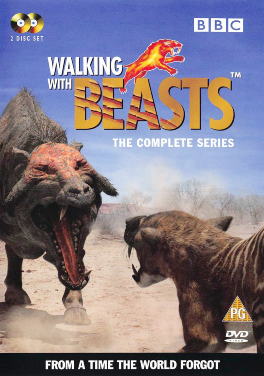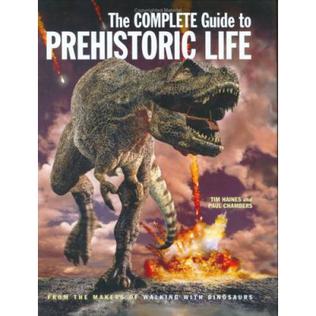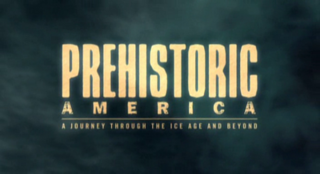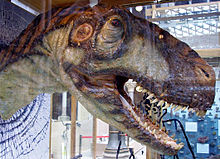
Walking with Cavemen is a 2003 four-part nature documentary television miniseries produced by the BBC Science Unit, the Discovery Channel and ProSieben. Walking with Cavemen explores human evolution, showcasing various extinct hominin species and their inferred behaviours and social dynamics. The original British version of the series is presented by the British researcher Robert Winston; in the American version Winston's appearances and narration is replaced with narration by Alec Baldwin.

Walking with Dinosaurs is a 1999 six-part nature documentary television miniseries created by Tim Haines and produced by the BBC Science Unit, the Discovery Channel and BBC Worldwide, in association with TV Asahi, ProSieben and France 3. Envisioned as the first "Natural History of Dinosaurs", Walking with Dinosaurs depicts dinosaurs and other Mesozoic animals as living animals in the style of a traditional nature documentary. The series first aired on the BBC in the United Kingdom in 1999 with narration by Kenneth Branagh. The series was subsequently aired in North America on the Discovery Channel in 2000, with Avery Brooks replacing Branagh.

Walking with Beasts, marketed as Walking with Prehistoric Beasts in North America, is a 2001 six-part nature documentary television miniseries created by Impossible Pictures and produced by the BBC Science Unit, the Discovery Channel, ProSieben and TV Asahi. The sequel to the 1999 miniseries Walking with Dinosaurs, Walking with Beasts explores the life in the Cenozoic era, after the extinction of the non-avian dinosaurs, particularly focusing on the rise of the mammals to dominance. The UK version of the series is narrated by Kenneth Branagh, who also narrated Walking with Dinosaurs, and the US version is narrated by Stockard Channing.

Sea Monsters, marketed as Chased by Sea Monsters in the United States, is a 2003 three-part nature documentary television miniseries created by Impossible Pictures and produced by the BBC Studios Science Unit, the Discovery Channel and ProSieben. Following in the footsteps of The Giant Claw (2002) and Land of Giants (2003), special episodes of the nature documentary series Walking with Dinosaurs, Sea Monsters stars British wildlife presenter Nigel Marven as a "time-travelling zoologist" who travels to seven different periods of time in prehistory, diving in the "seven deadliest seas of all time" and encountering and interacting with the prehistoric creatures who inhabit them. The series is narrated by Karen Hayley.

Space Odyssey: Voyage to the Planets, marketed as Voyage to the Planets and Beyond in the United States, is a 2004 two-part fictional documentary created by Impossible Pictures and produced by BBC Worldwide, Discovery Communications and ProSieben. Space Odyssey chronicles a fictional crewed voyage throughout the Solar System, which is used to convey scientific information on spaceflight and on the different planets. The programme was initially announced under the title Walking with Spacemen as an instalment in the Walking with... franchise of documentaries. Though the title was changed before release and its connection to the other Walking with... programmes was removed, it was broadcast under the original title in Canada. The special effects and scientific accuracy of Space Odyssey was praised by critics, though some criticism was leveled at the storylines and drama portions of the programme.

Walking with Monsters – Life Before Dinosaurs, marketed as Before the Dinosaurs – Walking with Monsters in North America, is a 2005 three-part nature documentary television miniseries created by Impossible Pictures and produced by the BBC Studios Science Unit, the Discovery Channel, ProSieben and France 3. Walking with Monsters explores life in the Paleozoic era, showcasing the early development of groups such as arthropods, fish, amphibians, reptiles and synapsids. Like its predecessors Walking with Dinosaurs (1999) and Walking with Beasts (2001), Walking with Monsters is narrated by Kenneth Branagh.

A nature documentary or wildlife documentary is a genre of documentary film or series about animals, plants, or other non-human living creatures. Nature documentaries usually concentrate on video taken in the subject's natural habitat, but often including footage of trained and captive animals, too. Sometimes they are about wildlife or ecosystems in relationship to human beings. Such programmes are most frequently made for television, particularly for public broadcasting channels, but some are also made for the cinema. The proliferation of this genre occurred almost simultaneously alongside the production of similar television series which is distributed across the world.

The Lost World is a 2001 British made-for-television film adaptation of the 1912 novel of the same name by Arthur Conan Doyle, directed by Stuart Orme and adapted by Tony Mulholland and Adrian Hodges. It was filmed at various locations on the West Coast of New Zealand. The 145-minute film was divided into two 75-minute episodes when broadcast on BBC One on 25 and 26 December 2001, receiving 8.68 million and 6.98 million viewers respectively. Bob Hoskins played Professor Challenger and was supported by James Fox, Peter Falk, Matthew Rhys, Tom Ward and Elaine Cassidy.

Primeval is a British science-fiction television programme produced for ITV by Impossible Pictures. Primeval follows a team of scientists tasked with investigating the appearance of temporal anomalies across the United Kingdom through which prehistoric and futuristic creatures enter the present, while simultaneously trying to stop a terrorist plot to bring about the end of the world. Primeval was created by Tim Haines, who previously created the Walking with... documentary series, and Adrian Hodges. It ran for five series, originally broadcast from 2007 to 2011.

Nigel Alan Marven is a British wildlife TV presenter, naturalist, conservationist, author, and television producer. He is best known as presenter of the BBC miniseries Chased by Dinosaurs, its sequel, Sea Monsters, as well as the ITV miniseries Prehistoric Park. He is also known for his unorthodox, spontaneous, and daring style of presenting wildlife documentaries as well as for including factual knowledge in the proceedings.
Tim Haines is a screenwriter, producer and director who is best known for his work on the BBC popular science shows Walking with Dinosaurs, Walking with Beasts, and Walking with Monsters. He is co-creator and executive producer of the ITV sci-fi drama Primeval, and founder of the production company Impossible Pictures.

The Complete Guide to Prehistoric Life is a 2005 encyclopedia featuring 111 of the prehistoric animals from the Walking with... series, as well as an additional one. It was published in 2005 by Firefly Books, and written by Tim Haines with Paul Chambers. It accompanies all of the main programs in the Walking with... series, including specials The Ballad of Big Al, The Giant Claw and Land of Giants but excluding Walking with Cavemen.
David Bruce Norman is a British paleontologist, currently the main curator of vertebrate paleontology at the Sedgwick Museum, Cambridge University. From 1991 to 2011, Norman has also been the Sedgwick Museum's director.

Land of Giants and The Giant Claw, marketed together as Chased by Dinosaurs in the United States, are two special episodes of the nature documentary television series Walking with Dinosaurs. Created by Impossible Pictures and produced by the BBC Studios Science Unit, the Discovery Channel and ProSieben, The Giant Claw was first broadcast on 30 December 2002, followed by Land of Giants on 1 January 2003. The two episodes stars British wildlife presenter Nigel Marven as a "time-travelling zoologist", interacting with dinosaurs and other prehistoric creatures, a drastic change in presentation from preceding entries in the Walking with... franchise.
Monsters We Met is a documentary produced by the BBC that later aired as a special on Animal Planet in 2004 which also included footage from Walking with Beasts and Walking with Cavemen. The show used computer-generated imagery to recreate the life of the giant animals that lived during the last ice age and explains how early humans encountered them. It also features humans as the main reason for the extinction of all great animals.

Wild New World is a six-part BBC documentary series about Ice Age America that describes the prehistory, landscape and wildlife of the continent from the arrival of humans to the welcome of the Ice Age. It was first transmitted in the UK & JP on BBC Two from 3 October to 7 November 2002. Like several other BBC programmes, it contains both computer graphics and real-life animals. Occasionally, footage of non-American counterparts of the extinct North American beasts are used in juxtaposition with footage of native American animals, like the pronghorn.
Impossible Pictures Ltd. was a London-based independent TV production company founded in 2002 by Tim Haines.
Jasper James is a British television producer, director and screenwriter. He is well known as the co-creator of several of the Walking with... series.

The first series of the British science fiction programme Primeval began on 10 February 2007 and concluded on 17 March 2007 after airing six episodes. Primeval follows a team of scientists tasked with investigating the appearance of temporal anomalies across the United Kingdom through which prehistoric and futuristic creatures enter the present. The first series stars Douglas Henshall, James Murray, Andrew-Lee Potts, Lucy Brown, Hannah Spearritt, Juliet Aubrey, Ben Miller and Mark Wakeling.















